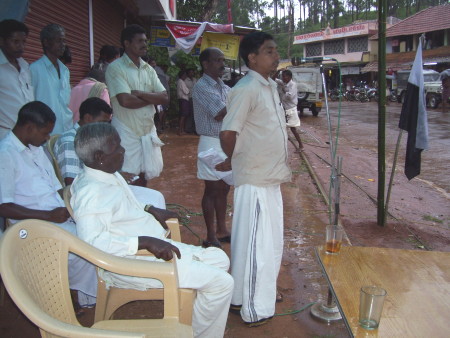AMS protests death of adivasi by Electrocution
Two months ago, there was a tragic accident in Thottapira village near Ambalamoola of Ayyankolli Area. Eighteen year old Elumban was electrocuted when he came in contact with a live electric line. While establishing connection in one of the houses of the village, the lineman from the Electricity department called on Elumban who was working in a nearby field to assist him by passing him the electrical main line lying on the ground. Neither realised that it was live and the moment Elumban touched it, he was fatally electrocuted. Though this can be termed an accident, it was caused entirely by the negligence of the Electricity department who should have turned off the main line before starting work.
As soon as the news of the incident spread, people from all the nearby sangams assembled at Thottapira. Ayyankolli area team and the sangam leaders supported the family to complete all the legal formalities and to file a complaint. They also made representations to the Police and other government officials.
Though a case was registered, there was no attempt by the Electricity department to provide compensation to the family. Many attempts were made to ensure some for of compensation but since all failed, the AMS decided to organise a public protest.

On 21st June 2008, in spite of monsoon weather, more than 400 men, women and young people from all the eight areas of AMS, assembled at Elumban's house and took out a procession from Thottapira to Ambalamoola. They urged the Government to take immediate action by providing compensation and financial support to the family. The event was covered by television channels and local newspapers, and the media joined the adivasis in highlighting the Government apathy to this tragedy.
After the procession, a
public meeting was also organised in Ambalamoola town. Leaders
belonging to all the five tribes and a few from the
neighbouring Wynad district of Kerala State spoke in the public
meeting.
Apart from forcing the Government to
consider the plight of the affected family immediately, the public
meeting was also used by AMS to underline the failure of many other
Government initiatives. Speakers from the
adivasi community minced no words while attacking the indifference
of the Government to the problems of the adivasis. Development programmes that sound quite well in
paper, when implemented often circumvent the guidelines and the
principles behind the programme. This results in a wastage and leakage of funds and
the community continues to be deprived. Adivasi leaders wanted a change
in this attitude, urged the Government to consult them before designing any development programme
and involve them in the implementation.
Vidyodaya gets recognition under Open School System
In the first week of June, Vidyodaya Trust got a letter which said,
Dear Sir / Madam,
I am to inform that your agency has been accredited provisionally as a Study Centre of National Institute of Open Schooling (NIOS) for Open Basic Education (OBE) Programme from the Academic Session 2007-08 and allotted a Study Centre Code No. OB-1904308, which may please be quoted in all future correspondence with NIOS.
This is a wonderful news for our education programme. During the last 10 years, we were caught up in a difficult balancing act. On the one hand, our goal and desire is to provide meaningful, relevant and good quality education to adivasi children. And, on the other, the numerous statutory and legal requirements stipulated by the Government often makes it impossible for us of to be creative and responsive to the needs of the community. For example, the rigid and demanding curriculum for instance leaves us with neither the time nor space to develop a culturally relevant syllabus. Under the NIOS we have far more freedom to develop an educational programme that is in keeping with our goals and aspirations. This was why we decided to apply for recognition under NIOS.
So, we were delighted when the Ministry of Human Resources Development of the Government of India finally accepted our application. It opens up a whole lot of opportunities and exciting possibilities for us. The most important aspect is that under the broad curriculum development guidelines, Vidyodaya will be able to teach the history of adivasi communities in Gudalur valley and their struggle for self reliance, as part of the regular curriculum itself. The cultural history, traditional knowledge of the community, vocational and life-skills that parents would like to pass on to the kids can all become part of the school curriculum.
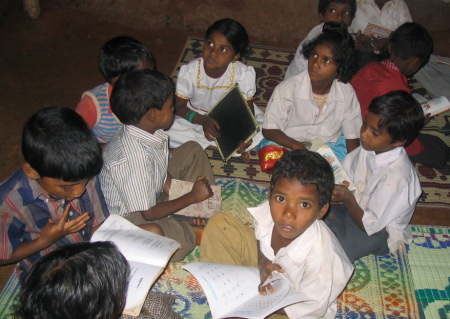
And what's more, community leaders can become teachers and can teach subjects like Honey Collection, Herbal Medicines, Construction of houses, Traditional Dances, playing musical instruments etc. - just like 'qualified' teachers teach Maths and Science to the kids. Possibly, all the Village libraries and Study Centres that have been started during the last three years can become extensions of the Vidyodaya School. The school can, literally, go to the doorsteps of the children.
The prospects excite us. But, it involves lot of work. Creative inputs from everyone is required. During the next two years, our challenge is to develop this curriculum and the required teaching materials.Health Financing - Consultation with the community
Our health insurance policy with Royal Sundaram Insurance Company came to an end in May. This programme was being implemented with the financial assistance of Sir Ratan Tata Trust, Mumbai from 2003. While we were still thinking about renewing the policy the Government under the World Bank funded Tamilnadu Health Systems project came forward offering to reimburse the costs of tribal inpatients. This would be on an initial pilot basis for one year. This raised the issue of whether we need to continue with the insurance programme or not. So, we took this opportunity to start extensive discussions with our community on the financial aspects of the health programme.
A series of meetings were conducted with all the Area Team members separately, and then with sangam leaders. Presentations were made highlighting the health parameters which are monitored and used to assess the health status of our people. For example, the immunisation status, number of patients seen in OP and admitted in Gudalur Adivasi Hospital, tribewise deliveries and mortality of children etc. were shared with each of the Area teams through graphical presentations. Along with these, the financial aspects were also discussed - the total expenditure on providing comprehensive health care to the people, the different sources of funding and the ideas for allocation of resources in future were debated.
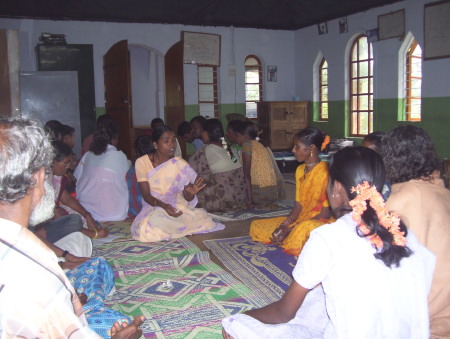
One of the messages that came out loud and clear from these meetings was that the insurance programme needs to continue - come what may. Though the premium paid by the community is only about 25% of the total premium paid to the insurance company, insurance is seen as an important mechanism to involve the community in the governance of our health system. And to give them a sense of ownership. Over the years, we have inculcated the habit of looking ahead and saving some money for the future needs in a variety of ways - health insurance is one of them. Everyone also strongly feel that nothing should be given totally free and people should be encouraged to contribute whatever they can. It was mooted that even though the Government is subsidising the costs of treating adivasi Inpatients in our hospital, people should continue to pay the insurance premium, and this could be used for outpatient care, emergency transport or costs of treatment when they are referred to bigger hospitals. That is the only way to ensure that our people access care with dignity. The participants felt that every sangam member will be willing to pay a bit more if we explain all the financial aspects of the programme in a clear manner.
This period also saw many Government officials visiting our Adivasi Hospital. ASHWINI has also been implementing other programmes under the Tamilnadu Health Systems Project. The Director of this project and other State / District level officers visited us to review progress.

We shared some of the problems faced by us while implementing the programme and the need to make some changes in the design. In an interaction with consultants from the World Bank team, we gave feedback on the bottlenecks in reaching the services to really needy villages and emphasised the need to continue interventions like the Bed Grant programme even after the WB funded programme comes to an end.
The new hospital building construction is going on in full swing. Details are available in this link.
Decentralised Planning Exercise
During the last decade, all the adivasi team members working in the area centres and in the institutions have been intensively trained on management issues, planning and designing programmes, monitoring and reviewing their activities regularly and in setting up the required systems. Now that the foundation has been laid, we are taking an important step of decentralising the planning and monitoring process. The focus of our next phase will be this.
As a first step, the area teams have decided to prepare a village specific Plan for all sectoral activities to be implemented in their Area. After few rounds of training and brainstorming, all the area teams have been preoccupied during the last three months with the preparation of their Area Plans for the next one year. The Animators listed their priorities with respect to community mobilisation and economic development activities. Similarly, the health animators pitched in with their objectives of providing good quality health care in the villages and the education coordinators came up with ideas for improving the educational status of adivasi children. This combined effort resulted in detailed villagewise plans for more than 200 adivasi hamlets.

The most important aspect is that the starting point was the situation of a village and the issues faced by the adivasi community in that village, rather than pre-designed programmes or sectoral intervention plans of the institutions. Even though many activities were similar in all the villages, the team could identify specific problems of villages to be tackled. For example, if drinking water was a problem in one village, the priority in another village was the resolution of a dispute between the traditional leaders. Similarly, while the focus in one village would be to start Savings, in another, it was to ensure that no one below 18 would get married; and to complete the survey of land under possession of adivasi families and to create government records in yet another village and so on.
This plan is not perfect as yet. And, the more important task of periodic monitoring and review at the Area Centres is to be ensured. But, this is an important step in the direction of enabling the adivasi community identifying their problems and challenges, setting priorities for themselves and working towards those goals collectively.
Children Camps - Catching them young
Six months ago, when the savings coordinators joined the team, we could see the result of investing in young children through such camps and exposure visits. The impact on the youth who had attended children camps a few years ago could be clearly seen, from their self-confidence, knowledge about the Sangam and attitude to their community. Hence, the education team drew up a plan to organise at least one Camp in each of the eight Areas and bring as many adivasi children as possible for these camps. In May, all the schools were closed for summer holidays. We used this period to organise 10 children camps.
Children from different villages were brought together, our area team members interacted with them for a day or two on different aspects, ranging from the cultural history of adivasis and political problems to health issues and role of Adivasi Munnetra Sangam etc. Though the initial planning was done by the education team, all the area team members actively participated in conducting the children camps and interacted with the children. Here, Eswaran is explaining about Tuberculosis to the children from Gudalur and Srimadurai areas.
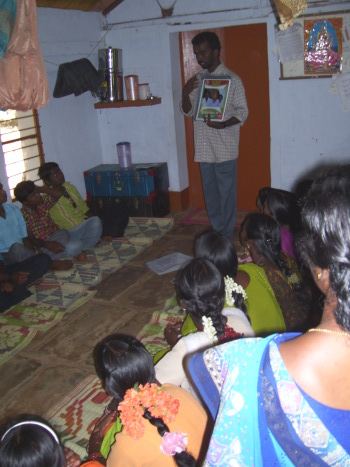
Children went on brief exposure visits as well to the Theppakadu Elephant Camp, Wildlife Museum and to the View Point near Gudalur. The Gudalur team worked with the adivasi staff working in the Camp and Museum and got permission for these visits before hand. All the children enjoyed these trips. And, there were lots of fun and games as well.
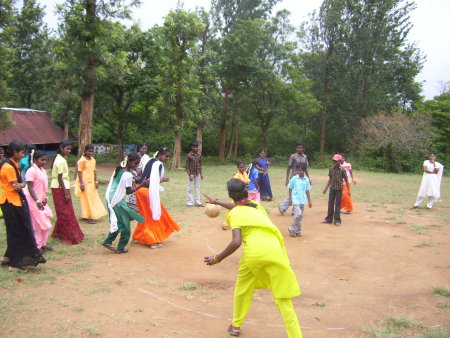
These children camps provided a good opportunity for the area team members to interact with the children and build a bond with them. It is our hope that these children will continue to take interest in the affairs of their community and will take an active role to build a better future.
Adivasis construct Area Centre in Ponnani
Ponnani Area Centre is currently being run from a small single room house. Given the expansion of activities during the last ten years, this room was found to be highly inadequate. With our current focus on making the Area Centres the hub of all the programmes and a big push towards decentralising the planning and review / monitoring of the activities through the Area Centres, a proper Area Centre with the required infrastructure is a must. During the last few years, Accord has been mobilising funds for equipping all the area centres with proper building and other infrastructure as a top priority. Ayyankolli and Pattavayal have constructed new buildings. Devala and Erumadu have acquired land and finalised their plans. As soon as our proposal to the Japanese Government gets passed, construction will start. Ponnani and Srimadurai have started construction recently.
The Ponnani area team drew up a plan for the building. After consultations with different people in the team, and with Anu - Krishna (our Architect friends), the plan for the Centre was finalised. And, the area team promptly started construction with the help of adivasi masons in the nearby villages.
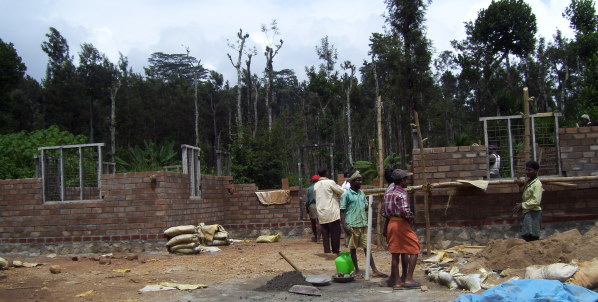
About ten years ago, Anu and Krishna ran an intensive training programme on construction technology for adivasi youth. It was heartening to see some of the trainees from Ponnani area taking up complete responsibility for the construction of the Ponnani area centre. Everyone was amazed at the quality of work by our adivasi masons and the speed at which the construction is proceeding. As with all the adivasi team members working in the different institutions, this is not a job or a labour contract, but they are involved in building a proper centre for their own community. Their involvement and most importantly, the pride with which they are working is significant. Sasi, one of the adivasi masons taking a lead in the construction, will surely tell his children when they grow up, "I built our area centre building !"
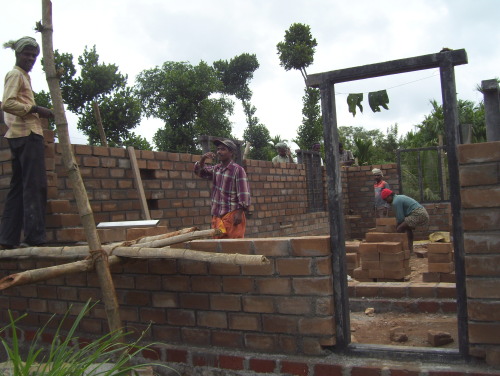
There is an economic aspect to this as well. As the entire team involved in the construction is from the adivasi community, the money spent by the organisation on this building is again going to the community members only and helps circulation of money locally and strengthens local economy. Though we had to buy cement and steel from outside, walls are constructed with the soil cement blocks, which were hand-made by adivasi youth. Once again, we realise the tremendous potential in construction activity and the economic benefits it can offer to our community, most of whom are still dependent on wage labour. We need to build some mechanism to tap this potential.
Regular updates about our other activities are available in the newsletters of Ashwini and Just Change .
| © Copyrights : Adivasi Munnetra Sangam, Gudalur. |
